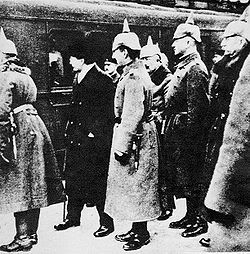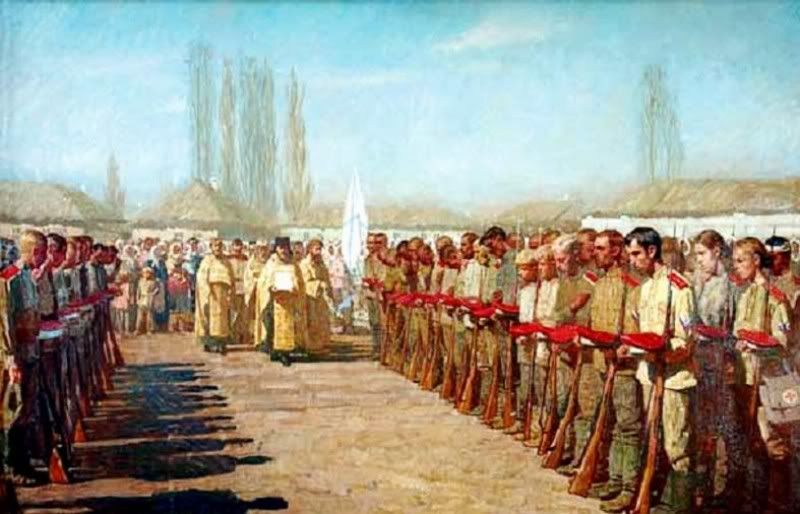
"The events of 1917 are so remarkable in that they could so easily have turned out dramatically different. February's revolution had forced the Tsar to step down, but the power that replaced his autocratic throne was mired in debate, conflict and political differences which proved impossible to resolve. No one in the Provisional Government could agree upon the very issues the people were most concerned over: land, bread and peace. The Great War had devastated an ill-prepared Russia, yet the Kadets and old Duma members that dominated the new government insisted on continuing the conflict. It was the perfect environment for more radical elements to seize the initiative. Yet when they tried, the public was not behind them due to the radicals' insistence on Revolutionary war in Europe to be a goal in the near future if not immediately. By the end of August German forces threatened St. Petersburg, and still nothing had been resolved. Faced with this realization, the calls for immediate peace came from a rather surprising source." - excerpt from The Great Bear Transformed: Russia's Painful Transition to Modernity
Anything resembling a Russian government had been split apart by factionalism and ideology as 1917 entered the final month of summer. Marxists were split between Socialist Revolutionaries advocating immediate land reform and the rising Bolsheviks who under the leadership of a new leader began to agitate for spreading revolutionary justice to the west. Lenin had died at the hands of cossacks acting independently of the government in March. The old duma parties were stuck between liberals, conservatives and moderates, none of whom had a popular mandate and were seen by people at large as representing the old landed classes. Outside the Provisional Government the need for a separate peace was abundantly clear: millions had died, millions more were starving, food riots were commonplace, industry had been run ragged and successes in the field had been nonexistent.

Vladimir Illich Lenin, assassinated by Cossacks in March 1917.

Aleksander Kerensky, member of the Provisional Government who was ousted until his election back into the Duma in 1920.
So with the Kaiser's forces poised to take the Russian capital, it was a man who had been outside the government for half a year who called for a cessation to the conflict. It is unclear whether being in exile in the countryside had made the real conditions of Russian peasants certain to him, or whether it was a bold political gambit by a man who had so far showed no real volition for such tings. Regardless of the why, Nikolai II emerged from his rural exile and proclaimed that the people had spoken, and their Tsar had heard them. Despite having no political power or even the throne, the deposed monarch called upon the new government to end the war and begin rebuilding Russia. It was an incredibly difficult thing for him to swallow given the humiliation of the Russo-Japanese War a decade before; however it was deemed necessary for the survival of the Russian nation.
Seeing this as a power play to restore monarchy the Marxists refused to respond, dragging their feet as reformers decided to not allow their former ruler to have all the credit. Agents were sent to meet with the German forces to negotiate an immediate end to the war in the east, and harsh terms were laid out for Russia's exit. The Baltic states were to remain in German hands as newly independent republics, giving Germany a friendly buffer in the east. Ukraine had risen up in a nationalist rebellion which the German army supported, and so too the breadbasket of the empire would separate. Similar sentiments existed in the Transcaucuses and that region would be discussed at a later date. Finland was also to be considered part of Germany's sphere of influence. In exchange Russia was allowed to leave the war and handle its domestic problems. Outlash from the West was immediate and swift - the Entente powers refused to recognize the Russian government and even threatened to land forces in the east to prevent Russian units from withdrawing. Despite such wild threats the reality of a great number of German forces heading west was enough to keep their forces focused on the Western Front. Political isolation of Russia became an official policy, though.

The Treaty of Brest-Litovsk ended Russia's role in the Great War, but alienated her from her former allies.
By November elections were to be held for a new parliament, but extremist elements refused to recognize the treaty signed by the Provisional Government's pro-peace ministers. Calling for a full proletarian revolution they seized the duma and ordered all Marxists to take to arms in order to create a true socialist state and sweep the capitalists away. While a large number responded to their calls, the greater population was weary of their insisting that a socialist state in Russia would need to cause revolts in other countries, which could then help Russia modernize and rebuild. Soon armed revolts by Reds were faced by a splintered group of so-called Whites, both units still loyal to the Provisional Government, liberal reformers, non-Bolshevik leftists, and other parties. This led to a conflict which would nearly tear Russia apart, lasting until 1919 when Red forces were finally encircled and defeated near the Transcaucus region.

White forces were lionized as the defenders of Russia's reformed government, despite the splintered nature of their commanders.

White Russian soldiers receive a blessing before heading out to reunify Holy Russia.
Yet even with victory the Provisional Government's support was wearing thin. Rumors abounded that the leaders were about to give in to pressure from the West to rejoin the war and launch a new offensive against the Germans in violation of the treaty. Disaster also struck when Red forces captured the deposed Tsar and his family, hoping at best to use them as a bargaining chip. When defeat loomed, individual Reds took the Tsar and his family to the basement of a rural estate and summarily executed them for crimes against the Russian people and the soviets. All except one - during the move to the estate, Grand Duchess Anastasia managed to run off despite Red forces pursuing her. Fortunately she found her way to White forces, who soon learned of the rest of her family's fate.

HRH Anastasia Nikolaevna Romanova, confirmed as Tsaritsa of Russia in 1919.
Monarchists rallied around Anastasia, calling for a new form of government to replace the crippled model in place. Long negotiations eventually led to the Ykaterinberg Accord, which established Russia as a constitutional monarchy with an elected parliament. Suffrage was extended first to all Russian men, then in 1921 to all citizens of the reformed Empire. Like the King of England, the title of Tsar would be fully ceremonial though technically the monarch had the power to dissolve parliament in an emergency. It was highly regarded that this was purely a formality and never to be used in any situation. With the last direct heir to the throne as a symbol of the new Russia, the monarchists formed a new Provisional Government with reformers and set upon the long, difficult task of rebuilding their country. Dissenters amongst the White forces were either forced to acquiesce or simply disappeared, but stability was tenuously restored. The revolution that had forced an abdication had resulted instead in an opportunistic restoration, and a new, smaller Russian Empire.

The new borders of the Russian Empire: dark blue is Russian Empire, dark green scribble is Poland, light green Ukraine, grey Lithuania, pink Latvia, dark red scribble Estonia, light blue Finland, brown is the Georgian Socialist Republic, orange the Protectorate of Armenia and the Transcaucasian dark red is the Azeri Republic.



